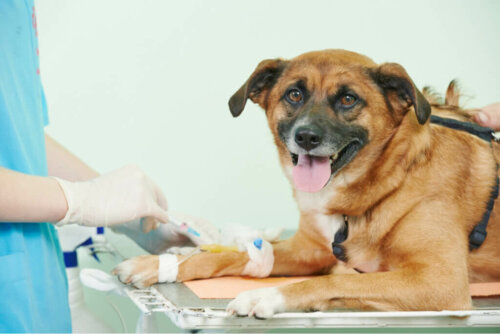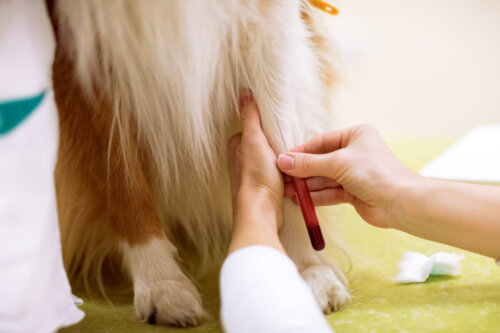Excessive Blood Clotting or Hypercoagulability in Dogs

There are several clotting disorders, and hypercoagulability in dogs is caused by excessive blood clotting.
For different reasons, this system works far more “efficiently” than it should. Thus, it’s more likely for thrombi to occur, with the risks that this entails. Diseases that predispose to hypercoagulability aren’t uncommon in veterinary medicine.
Dogs can suffer from numerous illnesses brought on by this complication, thus worsening their prognosis.
General information on hypercoagulability in dogs
Thrombophilia (sometimes called hypercoagulability or a prothrombotic state) are blood coagulation abnormalities that increase the risk of thrombosis. In these cases, clots occur inside a blood vessel, blocking it and not allowing blood to circulate.
This creates a thrombus that can fragment into emboli and travel through the bloodstream, obstructing blood flow in other places.
For hypercoagulability to occur, there must be a hemostasis disorder. In other words,a disorder in the body’s ability to stop bleeding.
Hypercoagulability in dogs: factors that predispose the animal
There are three main risk factors. In medicine, they’re known as Virchow’s triad:
- Endothelial injury or vessel wall injury.
- Impaired blood flow, making it slower.
- Alterations of the coagulation’s system own components. This is what experts know as hypercoagulability. The following can cause it:
- Platelet alterations; they show excess aggregation.
- Clotting factor alterations.
- A deficiency of natural anticoagulants.
- If the factors responsible for removing the clots don’t work correctly, this facilitates the formation of thrombi.
Three main mechanisms regulate an animal’s coagulation system:
- Antithrombin. As its name suggests, it works by preventing the formation of thrombi.
- Protein C, a natural anticoagulant.
- And, finally, the fibrinolytic system, responsible for removing clots.
These mechanisms work to prevent thrombus formation under normal circumstances and limit and localize clot formation. If one or more of these mechanisms fail, then thromboembolisms occur.

Causes of hypercoagulability in dogs
Below, we’ll explain some of the most common causes of excessive blood clotting, or hypercoagulability, in dogs.
Immune-mediated hemolytic anemia
This disease is an important cause of death in dogs due to the appearance of thromboembolism. It’s more common in middle-aged animals, and females also seem to be genetically predisposed to it.
Its appearance is associated with the consumption of certain chemical substances or medications and with the presence of some bacteria and viruses, tumors, or lupus, etc.
In most cases, the cause is unclear, and the veterinarian diagnoses it as idiopathic.
Liver diseases
The liver plays a fundamental role in hemostasis because this organ synthesizes and eliminates most clotting factors. Dogs who suffer from acute liver disease show prolonged prothrombin time (PT) and partial thromboplastin time (PTT; also known as activated partial thromboplastin time (aPTT)).
In other words, veterinarians consider them typically hypocoagulable animals with a tendency to bleed. Recent studies suggest that hypercoagulability may also appear.
Cushing’s syndrome, also known as hypercortisolism and hyperadrenocorticism
This is an endocrine system disease that causes the adrenal glands to work excessively.
There are many causes. However, in dogs, it’s more commonly due to a pituitary gland tumor or a tumor of the glands themselves. Nevertheless, it also appears due to excessive administration of corticosteroid treatments.
Thromboembolic disease is one of the most serious complications of hyperadrenocorticism. For example, when hypertension occurs, blood vessels are damaged, antithrombin is lost, and clotting factor levels increase, etc. In other words, everything contributes to the appearance of prothrombotic tendencies.
Other illnesses that occur with hypercoagulability in dogs: sepsis
Experts have described numerous clotting disorders in cases of sepsis and systemic inflammatory response syndrome (SIRS). For example, a clotting factor known as tissue factor tends to become overactive in these cases.
Thus, the activation of body anticoagulants, such as protein C, also reduces. Even when the immune system activates, platelet aggregation activates, sometimes in excess. In other words, in the case of sepsis, it’s very likely for a hypercoagulable state to occur.
Tumors
The incidence of thromboembolism in cancer is high and also seems to increase when the dog is treated with chemotherapy. This is why veterinarians establish anticoagulation protocols in these patients.
This hypercoagulable state in cancer is multifactorial and affects the three factors of Virchow’s triad. In fact, the tumor cells themselves can stimulate prothrombotic properties.

Is it possible to prevent these clotting disorders?
In addition to treating the aforementioned diseases, a series of guidelines can help prevent the onset of thromboembolisms. Pets need to lead healthy lifestyle habits every day.
Also, it’s important for them to stay active and go on long walks every day, whenever possible. If your dog has a genetic predisposition, then it’s very important for you to take them to a veterinarian as soon as possible to consult the possibility of permanent treatment.
All cited sources were thoroughly reviewed by our team to ensure their quality, reliability, currency, and validity. The bibliography of this article was considered reliable and of academic or scientific accuracy.
- Campos K, Seitz E. Revisión: Hipercoagulabilidad. Condiciones predisponentes y terapias en caninos. [Internet]. 2016 [cited 8 July 2020]. Available from: http://file:///Users/cuski91/Downloads/revision-hipercoagulabilidad-condiciones-predisponentes-y-terapias-en-perros.pdf
- King L, Boag A. BSAVA manual of canine and feline emergency and critical care. 2nd ed.
